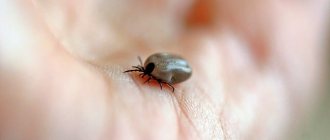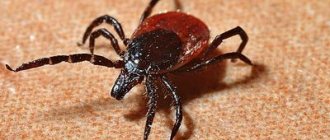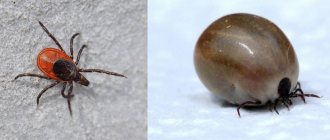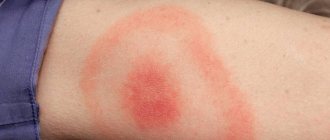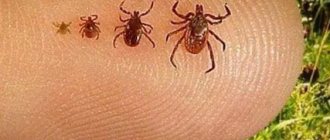Make an appointment by phone: +7 (343) 355-56-57
+7
- About the disease
- Cost of services
- Sign up
- About the disease
- Prices
- Sign up
With the beginning of the spring-summer season, ticks - parasites that feed on the blood of humans or animals - become more active. Their active period begins from late March - early April and continues until the onset of cold weather. The most favorable living conditions for ticks are considered to be air humidity of 80% and temperature of 18-22 degrees. Parasites live in short grass, short plants and low trees.
Only a few types of parasites that are carriers of diseases pose a danger to humans. However, bites from non-parasitic forms can cause severe skin irritation. Therefore, before a walk in the forest or park, it is important to read the recommendations on what to do if you are bitten by a tick.
.
Why are tick bites dangerous?
Some types of parasites are capable of transmitting severe diseases. Among the most common are tick-borne encephalitis (fever, symptoms of intoxication, inflammation of the spinal membranes) and Lyme disease (manifested by fever, headaches, weakness in the body, skin rashes). Lack of timely medical care leads to the development of neurological symptoms (with encephalitis), disability (with borreliosis) or lead to the death of a person. Non-parasitic tick species can cause irritation or suppuration when bitten.
Prevention
A tick bite during pregnancy is a nuisance, fraught with serious complications. The best prevention is timely immunoglobulin vaccination carried out during the planning period of conception. To minimize the likelihood of an insect attack, you must adhere to the following recommendations:
- avoid visiting parks and forests;
- wear a hat and clothes in light colors, but in which the insect will be visible;
- when walking, give preference to trousers and long sleeves;
- periodically inspect clothing and body;
- Use repellents approved during pregnancy.
What happens during a tick bite?
If you are bitten by a tick, this means that the parasite eats into the skin with the help of a hypostome (a special growth on the head).
Thus, the tick adheres to the human body quite firmly, remaining for a long time on its surface or under the skin. Tick saliva has anesthetic properties, so a person does not feel a bream bite. Together with saliva, pathogenic microorganisms enter the body and quickly spread through the bloodstream. Leading signs of a tick bite
In most cases, a person notices the suction of a tick while taking a shower or bath - in the form of a small dark dot. But sometimes, parasitic species can provoke a number of unpleasant symptoms:
- oval-shaped hyperemic area
- itching at the bite site
- increase in body temperature to 38-39 degrees
- muscle weakness, chills
- indifference and indifference to what is happening around
- painful eye sensitivity to light
- fatigue, drowsiness.
Be careful, tick!
Be careful, tick!
Ticks begin to be active from March-April (the peak falls in May-June), and in November their activity stops. 60% of all bites occur in the summer. Ticks like it to be warm and humid, but not too hot. For them, the comfort temperature is from +10 to +25 degrees. But temperatures of +30 have a depressing effect on them (they do not like direct sunlight).
Mite
– refers to arachnid animals, 3 mm long in a hungry state. They love moderately shaded deciduous and mixed forests. It is very important to know that ticks concentrate on forest paths covered with grass along the sides. There are many more of them here than in the surrounding forest.
Ticks do not sit on trees; they prefer vegetation that is closer to the surface of the ground (larvae sit on grass no higher than 30 cm, adults sit on bushes no higher than 1.5 m). Here they are in standby mode: they stretch out their paws and move them from side to side, waiting for a “victim” to cling to animal fur or human clothing. Parasites are able to smell an animal or person at a distance of 10 meters. Before attaching itself, the tick crawls over the body for 20-40 minutes, choosing the most suitable place - where the skin is thin and the blood vessels are located close to the surface. In humans, these are most often the legs, groin and armpit areas, back, neck and skin behind the ears. A tick can remain on a person for up to 5 days, on animals for up to 10 days, and then disappears on its own.
With the onset of their activity, the danger of contracting infections that are transmitted through tick bites increases: tick-borne borreliosis (Lyme disease) and tick-borne viral encephalitis. Infection occurs mainly during periods of mass recreation, berry and mushroom picking by the population. According to last year, 53.6% of tick attacks on people occurred in the forest zone. Often a tick is infected with both encephalitis and Lyme borreliosis at the same time.
The main mechanism of human infection is transmissible - during the sucking of a tick infected with the tick-borne encephalitis virus or Borrelia.
In addition, with tick-borne viral encephalitis, infection is possible:
- Nutritionally (by consuming raw milk from goats, sheep and cows);
- By contact (by crushing the tick at the moment of its removal from the human body).
In Lyme disease, transplacental transmission of Borrelia from mother to fetus is possible.
Post-infectious immunity in tick-borne viral encephalitis is persistent and long-lasting, and after tick-borne borreliosis, the disease can recur after 5-7 years.
Tick bites initially do not cause pain (saliva has an analgesic effect) and are not noticeable for some time, although sometimes there is itching at the site of suction. The presence of hook-like processes on the tick's proboscis makes it difficult to remove the tick. If the tick sucks blood for no more than 2-3 hours, then removing it will not be difficult. The faster the tick is removed, the less likely it is to develop a tick-borne infection.
Tick-borne encephalitis
– an acute viral disease, which is accompanied by severe intoxication, fever, and primary damage to the nervous system. The incubation period averages 3-7 days. The patient suffers from severe headache, vomiting, aching pain in the extremities, convulsions, tension in the neck muscles, photophobia, and impaired hearing. In response to infection with the tick-borne encephalitis virus (or vaccination against this virus), the immune system produces specific antiviral antibodies - immunoglobulin proteins. Already at the first symptoms of the disease, class M immunoglobulins appear in the blood. Their level reaches a maximum 3.5-4.5 weeks from the moment of infection and then gradually decreases over several months. Class G immunoglobulins appear in the blood a week after the onset of the first symptoms, reach a maximum 1.5-2.5 months after infection and persist throughout life, providing lasting immunity.
Tick-borne borreliosis
(Lyme disease) - caused by ixodid ticks - this is the most common group of ticks; they are found everywhere in the temperate zone of the Northern Hemisphere. The incubation period for borreliosis is several weeks. In the early stages, fatigue, chills, and headaches may occur. Also, with borreliosis, a characteristic rash occurs - erythema migrans (ring-shaped redness of the skin, which gradually expands). If the disease is not treated, serious problems may arise: joint pain, meningitis, numbness of the limbs, facial paralysis, memory disorders. Treatment of the disease is usually effective. However, if left untreated, the disease becomes chronic; in the later stages, severe damage to organs and systems develops: arthritis, persistent atrophic changes in the skin, damage to the nervous system and brain.
When infected, human lymphocytes begin to produce antibodies - special proteins (immunoglobulins) that should neutralize the bacteria. Normally, there are no antibodies to Borrelia in the blood serum. To confirm the diagnosis, a method is used that detects specific IgM and IgG antibodies to Borrelia.
In Lyme disease, immunoglobulin M (IgM) appears first in the blood, several days after infection. However, they can usually be identified at a later date (after 2-3 weeks). After about 6 weeks, the IgM concentration reaches a maximum and then gradually decreases (over several months and even years).
Antibodies of another type - immunoglobulin G (IgG) - their titer increases more slowly (4-6 weeks after erythema), the peak occurs in the 4-6th month.
IgG and IgM may be present in a person who has already recovered.
Why are tick bites dangerous?
What to do if you are bitten by a tick in the forest?
First of all, it is necessary to remove the parasite and send it for research to determine what species it belongs to and whether it is a carrier of the infection. It is better to entrust the removal of ticks from the skin to medical specialists. But if you can’t go to a medical facility in the near future, you will need to remove the tick from under the skin yourself. There are two ways to remove it safely:
- a small loop is formed from the thread, which is then thrown over the body of the tick and slowly made loose movements from side to side
- using tweezers - a special clamp can be purchased at the pharmacy before your upcoming walk in nature. Use tweezers carefully, as if the tick body is torn, part of it may remain under the skin. After removal, the skin must be treated with an antiseptic.
What are the possible consequences for pregnant women?
If the tick turns out to be benign (not a carrier), both mother and child have nothing to fear. In other cases:
- It is advisable to administer an immunoglobulin injection to a pregnant woman within the next four days after the bite if she is infected with encephalitis. This is an optional measure and it is up to the doctor to decide whether to administer this vaccine or not.
- If you are infected with bacterial pathogens, you must contact an infectious disease specialist. He will prescribe treatment for the pregnant woman or leave her under medical supervision for a week.
It is important to know
Encephalitis can complicate pregnancy, childbirth, and also contribute to miscarriage.
Symptoms and treatment of diseases caused by a bite
There are no absolute contraindications.
However, if you have a built-in pacemaker or an implantable cardioverter-defibrillator, you must provide a referral with permission from the attending physician (cardiologist-arrhythmologist or cardiac surgeon) before the procedure. Pregnant women must provide permission for the procedure from a gynecologist.
At the New Hospital, you can consult a cardiologist-arrhythmologist or a cardiac surgeon, and if necessary, the device will be configured for safe electromyography.
Tick-borne encephalitis is more common; the incubation period lasts 7-14 days. Signs include fever, muscle weakness and dystrophy, headache, nausea, and vomiting. Symptoms subside for eight days, but then 30% of patients develop signs of central nervous system damage. There is no specific treatment; symptomatic therapy is carried out aimed at eliminating symptoms and complications.
Lyme disease appears in the first few weeks, but can be asymptomatic for up to several years. Manifested by chills, increased body temperature, body aches, and stiff neck muscles. A characteristic feature of the disease is the appearance of migrating annular erythema. In some cases, after 1-3 months, symptoms of damage to the nervous or cardiac systems appear.
Treatment includes taking Doxycyline at a dosage of 200 mg in the first three days. Further treatment includes antibiotics, bactericides, NSAIDs, detoxification therapy and other treatments.
Monocytic ehrlichiosis is an infectious disease manifested by fever, skin rash and myalgia. Sometimes symptoms of damage to the central nervous system, urinary and respiratory systems occur. Treatment is carried out with tetracyclines, intravenous administration of glucose-saline solutions, and painkillers are administered. Drugs are used to normalize damaged organs.
You can make an appointment for a consultation and diagnostics by phone. (343) 355-56-57
Treatment during pregnancy
If you consult a doctor in a timely manner and there are no concomitant pathologies, the outcome for the woman is favorable. If tick-borne encephalitis is diagnosed in severe form, a decision is most often made to have an abortion for medical reasons, since treatment involves the mandatory use of drugs that have a pronounced teratogenic effect. In other cases, pregnancy is maintained using medications approved for expectant mothers as therapy.
Treatment of tick-borne encephalitis
During treatment, the patient must be admitted to hospital
The patient is hospitalized for the entire duration of treatment. General principles of therapy include:
- intramuscular administration of immunoglobulin preparations;
- taking antiviral medications (“Viferon”, “Cycloferon”, “Amiksin”);
- symptomatic treatment (administration of antipyretic, detoxification, dehydration, anti-inflammatory drugs);
- prescribing injections of vitamins B and C;
- gentle diet;
- strict bed rest, restriction of movements.
Treatment of borreliosis and ehrlichiosis
Therapy during pregnancy does not differ from the treatment of other groups of patients, with the exception of the ban on the use of drugs of the tetracycline group, which have a detrimental effect on the development of the fetus. In addition to taking antibiotics, the expectant mother must observe strict bed rest and strictly follow all the instructions of the gynecologist.
Means for the prevention of parasites in pregnant dogs
So, let’s summarize how to protect a pregnant dog from ticks using a modern remedy that will not harm the animal’s body and offspring?
Such a request can be satisfied by a complex drug - tablets against ticks and fleas. Let's consider their pharmacological action using the example of Simparic tablets. This is an innovative development of one of the leaders in the development and production of veterinary drugs.
- The main active ingredient of Simparica is sarolaner, which is active against ixodid, sarcoptoid (scabies), demodecoid (subcutaneous), psoroptoid (ear) mites and fleas.
After taking the tablet, the effect of the drug begins within 3 hours and lasts 5 weeks. Sarolaner penetrates the bloodstream and is distributed in tissues, including skin and mucous membranes. The drug has a detrimental effect on arthropods: by paralyzing the functioning of the nerve receptors of ticks and fleas, it causes their death. Moreover, the drug does not have a toxic effect on the dog’s body (4th, lowest hazard class). And it does not negatively affect the fetus during pregnancy. This allows Simparika to be used for the prevention of external parasites in pregnant and lactating dogs after consultation with a veterinarian.
Not only an attentive and careful attitude towards a dog in an “interesting situation” and a double portion of love for it, but also modern protection against parasites will help you comfortably endure this period and avoid dangerous diseases.
System
Systemic drugs are absorbed into the blood and act from the inside, while directly or indirectly almost all body systems are involved. The action begins immediately after the active substance is absorbed into the blood from the stomach and intestines. They act quickly and comprehensively on all types of ectoparasites and some types of helminths, depending on the active ingredient in the composition. Generally non-toxic to animals and well tolerated by all age groups.
Let's consider the advantage of the mechanism of action of systemic drugs using the example of a new generation drug - Simparika chewable tablets. The active substance, entering the body, is absorbed and penetrates the bloodstream, distributed throughout the skin and mucous membranes. Kills arthropods without being released onto the surface of skin and fur. Thus, contact with the animal becomes not dangerous for humans and other domestic animals. The drug can be used on pregnant and lactating dogs and puppies from 8 weeks.
►Attention:
There are systemic medications that are not suitable for use in pregnant or lactating dogs. There will be a warning about this in the instructions. If there is no direct indication, consultation with a veterinary specialist will help.
Advantages of using chewable tablets:
- Unlike external products in the form of external drops, sprays and shampoos, the components of the tablets are not washed off, providing protection for the entire declared period;
- Acting from the inside, they provide comprehensive treatment and prevention of diseases caused by external parasites, including demodicosis, ear mites and scabies;
- They guarantee the absence of tactile contact between a person and the drug when communicating with a treated animal. This is especially important for children, people with allergies or sensitive skin, as well as for other pets (such as cats), for whom the components may be dangerous;
- They guarantee the absence of tactile contact between a person and the drug when communicating with a treated animal. This is especially important for children, people with allergies or sensitive skin, as well as for other pets (such as cats), for whom the components may be dangerous;
- They guarantee the absence of tactile contact between a person and the drug when communicating with a treated animal. This is especially important for children, people with allergies or sensitive skin, as well as for other pets (such as cats), for whom the components may be dangerous;
- They do not cause difficulties when treating dogs with long and thick hair, which can be difficult when using some products in drops or sprays.
How to treat a pregnant dog against ticks?
With the onset of the warm season, all arthropods, including ticks, emerge from hibernation. Their active awakening begins when a stable positive air temperature of +10C and above is established. After a prolonged state of suspended animation, hungry ticks require restoration of nutrition; they become very active. They lie in wait and attack pets while walking, climbing onto plants and waiting for a suitable object to approach. Due to their small size and weight, they are located on stems, tree leaves, blades of grass and directly on the soil surface. They instantly cling to the fur of the future “owner”: for them it is a matter of survival. They quickly move to their favorite places - the neck, inguinal folds, interdigital space, the area around the ears and the auricle. To take your pet for a walk, you need to protect it from tick attacks.
Is it possible to treat a pregnant dog for ticks and how to do this so as not to harm her? - let's look at it in order.
If your baby is still small, he can get larvae or pupae from his mother. They will gradually develop into adults and can be harmful to your small dog.
Carriers of tick-borne encephalitis
The main carrier of the virus is the European taiga and forest tick, which is a hereditary carrier of the virus. That is, from an infected female the virus is transmitted to the offspring and subsequent generations of the tick. The blood of a person or animal is necessary for ticks to reproduce, which peaks in the spring and summer. This is the time when the risk of a tick bite is greatest. In addition to encephalitis, ticks carry Lyme disease, which is also a rather unpleasant disease with a slow development cycle.
It is not only the tick itself or the infected animal that is dangerous. Feces and other waste products are also dangerous. The fluid inside an encephalitis tick is a potential source of infection. When scratching the skin and getting into the bloodstream, indirect infection is quite possible.
Goats can also carry the virus. In this case, infection occurs through unprocessed goat milk consumed as food. The virus dies when boiled, does not tolerate sunlight, you can drink any boiled milk without fear.
Chewable tablets are one of the drugs of choice for veterinarians.
Veterinary pharmacology is continuously improving means and methods of counteracting arthropod parasites. Modern drugs are designed in such a way that their use is possible for most dogs in different physiological states, including pregnant and lactating dogs. It is important to select the product as carefully as possible so as not to harm future offspring. When choosing a means of protection against ticks for pregnant dogs, you should give preference to drugs that do not have a negative effect on the offspring and the mother’s body. Simparika chewable tablets have these properties.

